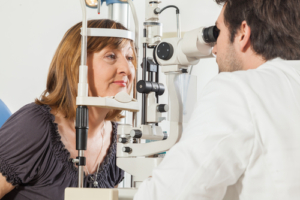How Often Do You Need a General Eye Exam?
Keeping up with routine eye exams can ensure long-term eye and vision health. A comprehensive examination gives your optometrist or ophthalmologist a complete picture of your eye health.
During a general eye exam, your eye doctor can catch and diagnose many eye diseases and eye conditions. Timely diagnosis and treatment of eye conditions are essential in preventing vision loss and blindness.
Keep reading to learn more about how often you should have a general eye exam and what to expect during an eye exam.
Baseline Eye Exams for Adults

Based on the American Academy of Ophthalmology recommendations, adults without visible signs of eye problems or risk factors for eye conditions should schedule an eye exam in their twenties with another one in their thirties. You should have a baseline eye exam to screen for eye diseases and conditions at age 40.
Turning 40 is critical because this is when many vision changes begin, and early signs of some eye conditions may appear. However, if your eyes are not healthy or you have existing refractive errors, you will need eye exams on a much more frequent basis, including if the following applies:
- You have high blood pressure or diabetes
- There is a family history of eye disease or vision loss
- You take medications known to cause eye-related side effects
- You’ve experienced an injury, an infection, eye pain, patterns of light, or sudden flashes or floaters
- You wear contact lenses or glasses
Baseline eye examinations enable your ophthalmologist to diagnose eye conditions or health issues early when treatment is most effective. Depending on the findings of a baseline exam, your optometrist or ophthalmologist will recommend how often you should schedule eye exams moving forward.
Sticking to the schedule your eye doctor provides is crucial as your risk for certain eye diseases increases with age.
Older Adults and Eye Exams

If you’re age 65 and beyond, you’ll need to schedule a complete eye exam every year. Your optometrist or ophthalmologist will look for signs of age-related eye conditions like:
- Cataracts
- Macular degeneration
- Diabetic retinopathy
- Glaucoma
Your eye doctor will then guide you on how frequently you need to follow up, depending on your needs.
What Optometrists or Ophthalmologists Check During General Eye Exams
An eye exam is painless and straightforward. It takes about 45 to 90 minutes to complete. Here’s what to expect during your eye exam:
Your Detailed Medical History
Your eye doctor will ask about your vision and general health. They’ll want to know about the following:
Any Medications You Take
Many medications can cause side effects that may unintentionally affect your eyes. Your optometrist or ophthalmologist will need to know the medications you’re taking to monitor how your eyes react while you’re taking these.
Your Allergies

Due to seasonal allergies, many people experience uncomfortable symptoms like dry eyes, itching, and a burning sensation. Knowledge of allergies allows your eye doctor to create a treatment plan to help relieve any discomfort.
Your Medical History
Some medical conditions like high blood pressure and diabetes increase your risk of eye complications. Equipped with this information, your optometrist or ophthalmologist can closely monitor any changes in your vision or eye health during future visits.
Your Family Medical History
Knowing your family medical history helps determine your likelihood of developing conditions like macular degeneration or glaucoma. An optometrist or ophthalmologist can use this information to recommend steps to reduce the risk of developing these conditions.
Your Lifestyle

Lifestyle plays a role in how healthy your eyes are. Your optometrist or ophthalmologist can suggest lifestyle changes to minimize your risk for certain eye diseases.
If You Wear Glasses or Contact Lenses
This information will help your eye doctor keep your prescription updated annually and change it as necessary.
Visual Acuity
Visual acuity tests how well you can see with each eye at various distances. You’ll cover one eye at a time and use the other to read letters on a chart about 20 feet away.
The letters typically decrease in size from the top to the bottom line.
Your eye doctor will then use your responses to gauge whether you have 20/20 vision or require corrective lenses.
Your Prescription
The optometrist or ophthalmologist will ask you to look at an eye chart through a phoropter. A phoropter is a device with multiple lens combinations.
It looks like a mask with holes to enable your eyes to see through.
Your eye doctor will place the phoropter in front of your eyes and show you different lens choices.
You’ll be asked which lens options make the letters or numbers on the wall chart look clearer. Each eye is tested individually for the most accurate results.
Your eye doctor will determine the most accurate prescription to correct your vision based on your answers.
Pupils
A pupil exam is a vital part of a comprehensive eye examination. It can reveal issues with your vision. To examine your pupils, your optometrist or ophthalmologist will shine a light into your eyes and observe your pupils closely to see whether or not they shrink.
Pupils usually respond by becoming smaller. If they widen or don’t respond, it could indicate several eye conditions, including optic nerve damage. Further testing will be necessary to diagnose the root of the problem correctly.
Front of the Eye
Your optometrist or ophthalmologist will use a slit-lamp microscope to see the front of your eye clearly. This area includes your cornea, iris, lens, and eyelids. The test can find scratches or scars on your cornea and cataracts.
Eye Movement
Using an ocular motility test, your eye doctor will confirm if your eye muscles are working properly and whether your eyes are correctly aligned.
Side or Peripheral Vision
Loss of peripheral vision could be a sign of glaucoma. A visual field test can evaluate your side vision. Testing your peripheral vision can pick up on issues with your eyes before you notice them. Patients often don’t realize they have lost peripheral vision until it’s already occurred.

Eye Pressure
Your eye pressure is measured through a test called tonometry. The test may involve directing a quick, light puff of air onto your eye or gently placing a pressure-sensitive tip against or near your eye.
You’ll have numbing drops applied first to ensure comfort during the test. High eye pressure or intraocular pressure could be a sign of glaucoma.
Retina and Optic Nerve
Your optometrist or ophthalmologist will apply special drops to dilate or widen your pupils. Dilating your pupils allows your eye doctor to check your optic nerve and retina for any signs of glaucoma damage. Your eyes will likely be sensitive to light for a few hours after this test.
Other Tests Performed During a General Eye Exam
Further testing may be required depending on the outcome of your exam. These can include:
- Fundus photos
- Topography
- Automated visual field
- Fluorescein angiography (FA)
- Optical coherence tomography (OCT)

Don’t Put Off Your General Eye Exam
Even if you think you have good vision, baseline eye exams are necessary for healthy eyes. They ensure you can enjoy your vision, no matter your age.
Do you need a general eye exam? Schedule yours today at Eye Consultants of North Dakota in Fargo, ND!



